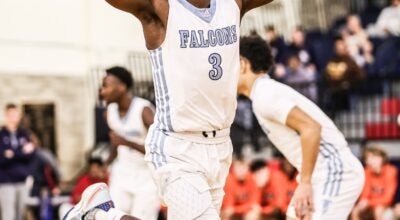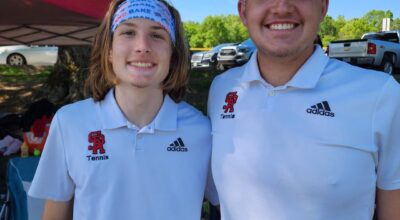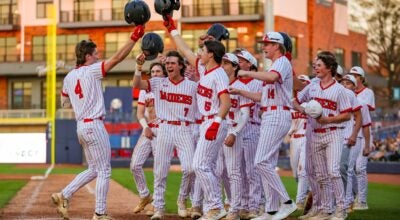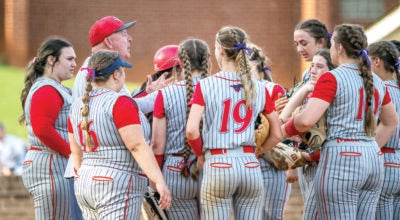Football: Reunion honors legendary coach Pete Stout
Published 12:00 am Sunday, May 8, 2016
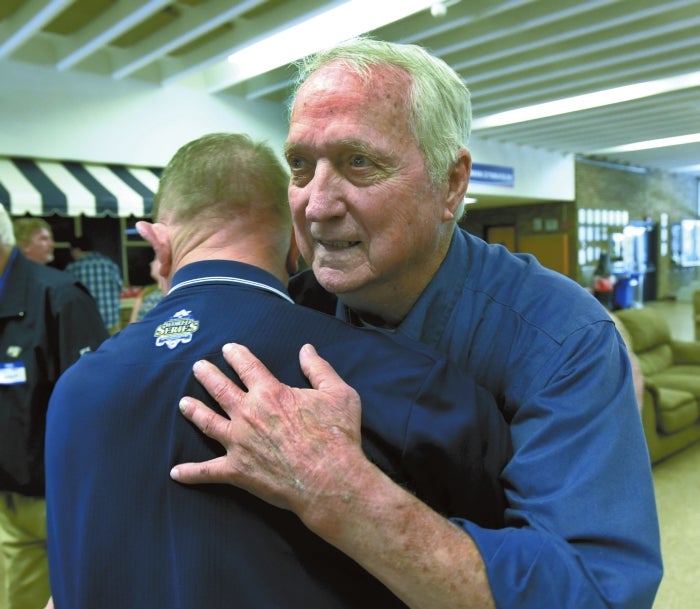
- Pete Stout gets a hug during a reunion at Catawba College's Goodman Gym. Wayne Hinshaw/for the Salisbury Post (file photo)
By Mike London
mike.london@salisburypost.com
SALISBURY — It was 60 years ago when Pete Stout, recruited out of Haw River High School by Catawba to play basketball, instead became an All-American for the Indians’ football team.
It was 50 years ago that J.J. Knox, the superintendent of Salisbury city schools, announced the hiring of Stout as Boyden High’s new football coach.
Years have passed, but Stout’s legend has grown, rather than diminished. His 234-63-14 record as a Hall of Fame high school coach, is overwhelming.
“Pete was a good organizer and he knew how to treat kids,” said Mike Carter, who played for Stout at Western Alamance and coached under him at Burlington Williams. “He ran clean programs. He went round and round to several schools, but he did well everywhere he went.”
On Saturday, Stout’s former assistants and players gathered around the 79-year-old coach for a reunion at Catawba’s Goodman Gym. The reunion included the standard war stories but there also was plenty of heartfelt emotion.
Stout impacted lives, all for the better. There were many “thank yous” as former players exited the gym.
Stout knew when he was still a teen that he’d become a coach and he prepared for his life’s work diligently. He learned from his high school coach, Bud Phillips. At Catawba, Stout was more than a back. He memorized playbooks and sat in on meetings to learn every position.
After graduation, he worked as an assistant at Burlington Williams. In 1959, when he was 23, Stout became the head coach at a tiny Alamance school — Altamahaw-Ossipee.
That was the springboard to the head job at Western Alamance, when that school opened in 1962.
Stout’s success at Western Alamance didn’t go unnoticed in Salisbury where people remembered Stout’s playing days at Catawba. Many believed he was the right man to return Boyden to the glory days (two state championships) it had enjoyed in the 1950s under coach Bill Ludwig.
From 1960-65, Boyden’s Yellow Jackets won just 11 times.
Stout remembers his interview with Dr. Knox.
“Boyden was playing 3A, the state’s biggest classification then,” Stout said. “There was concern that I wouldn’t be able to manage a large of number of players at a big school. But I was offered the Boyden job. I knew (former Catawba player) Charlie Little was already at Boyden, I knew him from coaching against him, and I knew he could coach defense. I called Charlie and asked if he’d stay if I took the job, and he said he would. Charlie and I would coach together more than 20 years.”
Playing in a league with the Winston-Salem, Greensboro and High Point schools, Boyden went 6-3-2 in Stout’s first season in 1966. His formula was simple. He put together a staff. He two-platooned, put his studs on defense and ran the ball.
Ron Raper, who would become one of Stout’s loyal assistants, was his first team captain. Raper attended Saturday’s reunion.
Integration played a role in Stout’s success story. Boyden was getting a few black players by Stout’s first season, including future NFL player James Teal.
In 1967, Boyden left the state association, became a member of the Western North Carolina High School Activities Association and began play in the South Piedmont Conference.
By 1968, a strong Boyden squad included five black stars — sophomore defensive tackle Robert Pulliam, senior running back Derrick Anderson, junior offensive tackle Reggie Childers and sophomore backs Aubrey Childers and Roger Jackson.
Stout’s 1969 team was 8-2 but didn’t make the WNCHSAA playoffs. It was a tough road in those days, and losses to Concord and Lexington knocked out Boyden.
“The SPC was a very challenging league,” Stout said. “Every school had a great program.”
When J.C. Price, Salisbury’s black school, was closed in 1969, it meant change for the fall of 1970. Now Boyden had two teams’ worth of players — the ones from Boyden and the ones from Price.
“We fell into some pretty good players,” Little said with a smile.
Rob Patton, the son of Bob Patton, Stout’s offensive line coach, attended Saturday’s reunion and told of many thank-you letters his father has received over the years for the way the coaches handled a challenging situation.
“I think the school could’ve blown up, but the coaching staff played the best 22 guys, black or white, it didn’t matter, and there was mutual respect,” Patton said.
Stout remembers that season well. It may have been the most talented high school team he coached.
“The consolidation of two schools into one went smoothly at Boyden, smoother than any other school I know of because of two men — James Bridges in football and Fred Evans in basketball,” Stout said. “They’d been Price’s coaches, but they brought their players in. They could’ve been resentful, but they weren’t. They helped everyone get along. They made it easier.”
Boyden’s 1970 team won a game-of-the-century showdown with East Rowan for the Piedmont championship but lost to Shelby, 13-7, in the WNCHSAA championship game.
After that disappointment, Stout didn’t know if he’d ever win a title, but he would win three.
By 1971, Boyden’s name had been changed to Salisbury High, and the Yellow Jackets mascot had given way to the Hornets. Red was added to the school’s black and gold colors as a salute to the Price Red Devils.
Stout’s Salisbury teams won a WNCHSAA co-championship in 1971 (tying South Point). Then Salisbury beat Watauga for the crown in 1973 and won another in 1974 with a payback victory at Shelby.
Joey Barrier, a defensive end, was a senior on the 1973 championship team, and attended Saturday’s reunion. He pulled out his scrapbooks Saturday morning.
“Coach Stout gave us a rule book,” Barrier said. “He told us if we couldn’t give 100 percent he didn’t want us on his team and he told us football wasn’t a sissy sport and he expected us to behave the right way. There wasn’t any fighting or cursing, and he told us to forget about our girlfriends until the offseason. We didn’t argue with him. We took everything he said as fact and we would’ve run through a brick wall for him.”
Barrier fondly remembers Salisbury’s stunning, 52-0 win against Thomasville in the 1973 SPC championship game and the 42-12 win against Mooresville in the Piedmont championship game that followed.
“Mooresville had two All-American backs,” Barrier said. “But we beat ’em up pretty good. One didn’t dress for the second half.”
Danny Winecoff, a Shrine Bowl defensive lineman, played a key role on the 1973 and 1974 title teams.
“Well, I remember that Coach Stout made me get a haircut,” Winecoff said. “We were very successful, and a big part of that was Coach (Bill) Cansler at Knox Junior High running the same offense and defense Salisbury was using.”
Stout’s Boyden and Salisbury teams went 83-20-10 in his 10 seasons. Salisbury beat Asheboro, 17-0, in his final game, in 1975. That team went 8-1-1 but didn’t make the playoffs because of a scoreless tie with Concord and a 17-14 loss to Lexington.
Stout’s teams never lost to Rowan opponent in his decade in Salisbury.
“He told us if we ever lost to a county opponent and let those country boys laugh at us that we’d have a two-hour Saturday practice,” Barrier said. “But we never had that practice.”
Stout also is proud of what his track teams accomplished. There were WNCHSAA championship teams in 1970, 1971, 1972 and 1976.
“Rowan County track was really good then at every school,” Stout said. “If you could win the county, you could win the state. We got our best athletes out there, and we did a good job of record-keeping. We kept stats and our runners always knew what records they were shooting for.”
It’s hard to believe, but after his time in Salisbury, Stout was even more successful when he and his staff moved on to Burlington Williams.
The 1978 Burlington Williams team came an inch or so from winning another state title on a frozen field at Watauga. But Williams would win 43 straight games under Stout, taking the 1980 and 1981 3A championships with 14-0 records.
Jeff Stout was a receiver for his father on the 1980 and 1981 title teams.
“I played two years of jayvee at Williams and two years of varsity, and those four teams were 48-0,” Jeff Stout.
Stout’s teams in Burlington went 71-12. That got fans clamoring for him to pull Catawba’s program out of lean times. He took his best shot from 1983-86. His four Catawba teams went 13-29-1.
“But he made a difference when he came in for my last two years,” said former Catawba quarterback Bobby Myers. “He brought organization and community support picked up. We got nice new uniforms. My senior year (1984) we were only 3-8, but there were some close losses. We beat Guilford when they were ranked No. 8. He got us back on track.”
Stout won the final college game he coached — 28-20, against rival Lenoir-Rhyne. Catawba went 5-6 in each of his final two seasons.
Stout needed four more years to qualify for full retirement from the school system, so he headed to Freedom High in Morganton next. He coached those four years from 1987-90 and showed he hadn’t lost his touch with high school kids. Freedom went 32-12.
After that, Stout would spend more time in prep football as Carter’s defensive coordinator at Mooresville. Stout mentored Mooresville assistant coach Joe Pinyan, who would one day take his own turn at reviving Salisbury’s football fortunes.
Stout’s records for all of his high school seasons were on display on a chart his son posted in the gyn lobby on Saturday, complete with offensive and defensive rankings.
Stout’s stingiest defensive team was the 1963 Western Alamance squad, while the 1980 Burlington Williams team boasted the most prolific offense.
But the echoes of those powerful Boyden and Salisbury teams that Stout coached will be heard for another 50 years.


